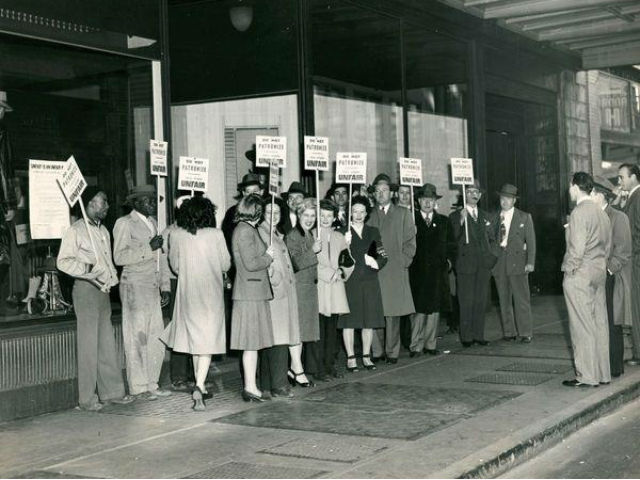Our stages of grief and outrage over the Trump presidency have reached the refusing-to-show-up-for-work phase, with today’s national Day Without Immigrants and Friday’s proposed national general strike (another women’s general strike has been called for March 8). This striking number of strikes behooves SFist to go all #ThrowbackThursday and recall that the Bay Area was once home to the largest general strike in U.S. history with the 1946 Oakland General Strike, and the 1934 San Francisco General Strike that marked to first-ever complete shutdown of a major American port city.
Both of these general strikes were catalysts in the U.S. labor movement. And both events — god, I say this these days every time I write a historical essay or watch an Amazon-produced TV show — have remarkable parallels to the situation we now face living in Donald Trump’s America.

San Francisco General Strike of 1934
You have already been familiarized with the 1934 San Francisco General Strike, even if you don’t realize it. It is depicted in the second panel of Mona Caron’s Market Street Railway Mural at Church Street and 15th Street, the painting that shows a decade-by-decade illustration of San Francisco history. The panel portrays a July 5, 1934 event known as Bloody Thursday, a melee of rioting, tear-gassing, and billy-clubbing that left two San Francisco strikers dead and 80 more injured.
Back in 1930s Depression-era San Francisco, the West Coast Longshoreman’s Strike had for two full months shut down most ports in Portland and Seattle. The ports of San Francisco were closed down entirely, marking the first such total shutdown of a major port city in American history. Tens of millions of dollars in imports sat languishing on the docks, and the National Guard was called in to allow strikebreakers to walk through the picket lines. The Guard was given orders to shoot, and that’s just what they did as you can see in the mildly propaganda-fueled newsreel below.
The mood of the city was furious over the killings. A mass funeral procession of 50,000 marched down Market Street on July 9, and pretty much every union and non-union employee in the city joined in the general strike declared on July 14. Food deliveries were permitted and the unions gave blessing for a few restaurants to remain open, but otherwise business in San Francisco was brought pretty much to a complete halt while raids and riots rocked the town.
But the general strike worked. Within four days, the International Longshoremen’s Association was offered arbitration in which they won a pay raise to 95 cents an hour (they had been asking for a dollar). Dock workers all along the west coast went back to work, though for several decades observed a July 5 Bloody Thursday memorial by closing down the ports on that day.
 Image: LocalWiki
Image: LocalWiki
Oakland General Strike of 1946
The post-World War II era saw a boom in housing prices and cost of living, but wages remained stagnant. That set of conditions led to the largest wave of strikes in U.S. history, and at one point in 1945 they were 1.6 million Americans on strike.
Here in the Bay Area, the predominantly female workforces of department stores Kahn’s and Hastings attempted to unionize. A few of the workers who’d acted as organizers were promptly fired, but in solidarity some 400 of their colleagues all walked off the job in October 1946. After two months of picketing, police eventually intervened to assist strikebreakers and deliveries into the department stores.
But newspaper images of police hassling women rubbed Alameda County the wrong way. Every single American Federation of Labor union voted to join the retail clerks’ strike. On December 3, 1946, every Oakland business save for pharmacies, food stores and bars was closed. More than 100,000 refused to work, constituting the largest general strike in U.S. history
Those are impressive numbers, but the strike was a short-term flop. Half of all strikers went back to work the following day. On the third day, the AFL leadership took a deal in which police were called off from protecting strikebreakers in exchange for declaring the general strike over. Support had quickly dissipated, and the retail workers did not get their union.
Until they did. The AFL lost a great deal of support locally for what was perceived as a quick cave-in. Many workers organized through the notoriously more radical Congress of Industrial Organizations (CIO), and their efforts produced a near-sweep in the Oakland City Council elections of 1947. With a more union-friendly council in place, the Oakland Retail Merchant’s Association saw the need to pivot and within a week recognized the retail clerk’s union
The Occupy folks put on another general strike in Oakland in 2011. Friday’s national general strike in protest off Trump does not involve any picket lines per se, though one building Financial District building will be the target of a 12 Noon protest. You can take a wild guess which building.
Related: More Than 100,000 Attend Women's March In San Francisco As City Hall Lights Up Pink
Image: Mona Caron's Market Street Railway Mural (Joe Kukura, SFist)
